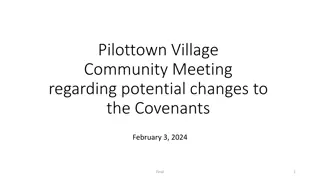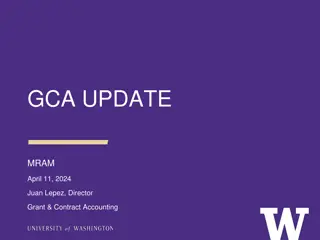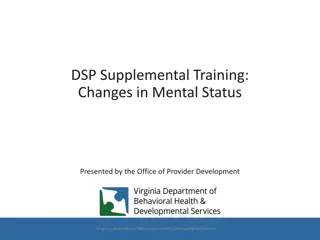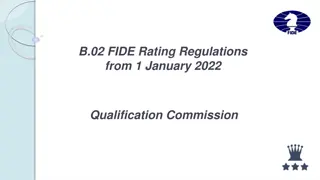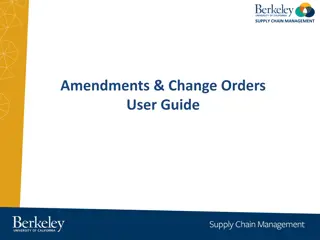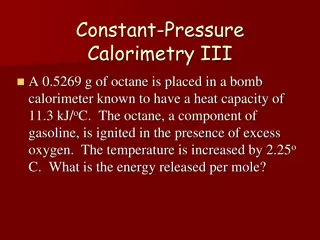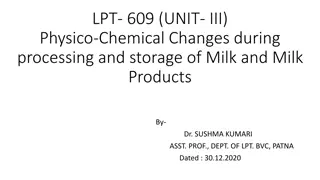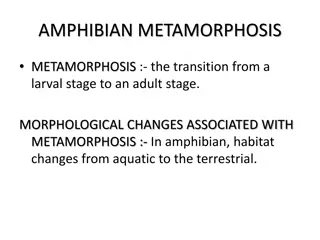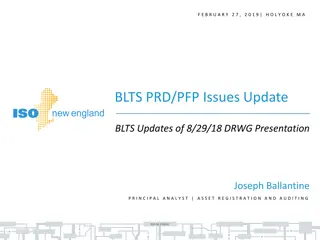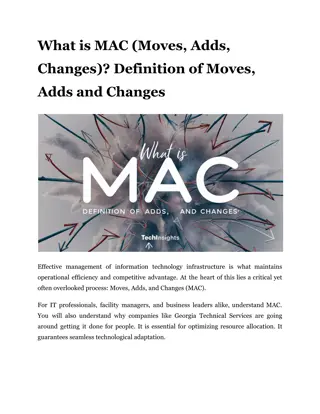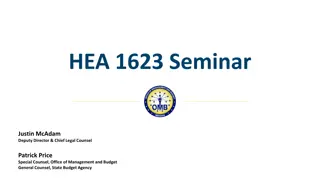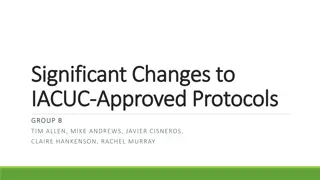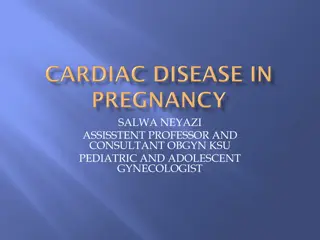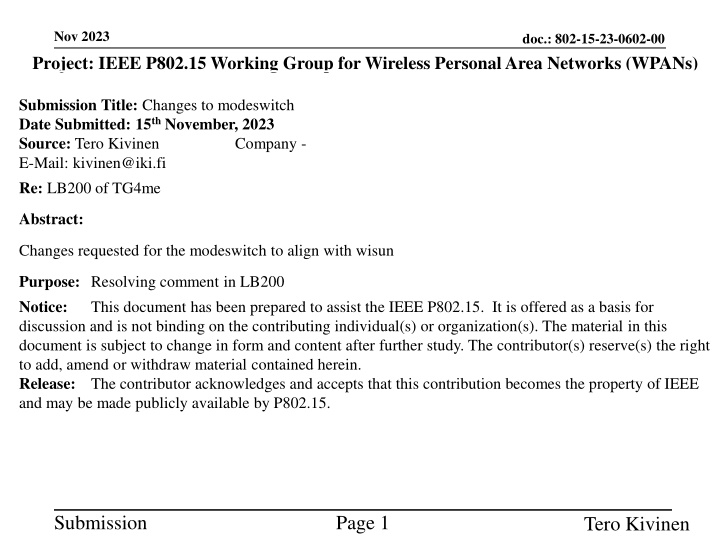
Changes to Mode Switch Alignment in Wi-SUN Standards
"Request for changes to the mode switch to align with Wi-SUN standards in IEEE P802.15 Working Group for Wireless Personal Area Networks. Includes details on the requested adjustments and the purpose for realignment."
Download Presentation

Please find below an Image/Link to download the presentation.
The content on the website is provided AS IS for your information and personal use only. It may not be sold, licensed, or shared on other websites without obtaining consent from the author. If you encounter any issues during the download, it is possible that the publisher has removed the file from their server.
You are allowed to download the files provided on this website for personal or commercial use, subject to the condition that they are used lawfully. All files are the property of their respective owners.
The content on the website is provided AS IS for your information and personal use only. It may not be sold, licensed, or shared on other websites without obtaining consent from the author.
E N D
Presentation Transcript
Nov 2023 Project: IEEE P802.15 Working Group for Wireless Personal Area Networks (WPANs) doc.: 802-15-23-0602-00 Submission Title: Changes to modeswitch Date Submitted: 15th November, 2023 Source: Tero Kivinen E-Mail: kivinen@iki.fi Re: LB200 of TG4me Company - Abstract: Changes requested for the modeswitch to align with wisun Purpose: Resolving comment in LB200 Notice: This document has been prepared to assist the IEEE P802.15. It is offered as a basis for discussion and is not binding on the contributing individual(s) or organization(s). The material in this document is subject to change in form and content after further study. The contributor(s) reserve(s) the right to add, amend or withdraw material contained herein. Release: The contributor acknowledges and accepts that this contribution becomes the property of IEEE and may be made publicly available by P802.15. Submission Page 1 Tero Kivinen
Nov 2023 doc.: 802-15-23-0602-00 Wi-SUN Don Sturek requested that the modeswitch in section 20.5 for SUN-FSK should be somewhat aligned with Wi-SUN. Submission Page 2 Tero Kivinen
Nov 2023 Format of Mode Switch PHR doc.: 802-15-23-0602-00 Submission Page 3 Tero Kivinen
Nov 2023 doc.: 802-15-23-0602-00 From Don The main difference is we have our internal format of what you are calling Channel Info . The main thing is to keep the length from bits 1 through 10 the same and have it cover the SUN FSK, SUN OFDM and SUN O-QPSK new modes. I don t think we should adopt the Wi-SUN version here and we will align so long as whatever you define fits into bits 1 through 10 (I don t think it would be productive for us to try to align our PhyModeID to what you want do with Channel Info. Submission Page 4 Tero Kivinen
Nov 2023 doc.: 802-15-23-0602-00 Parity calculation in 15.4 The generator polynomial for the Checksum field is a Bose Chaudhuri Hocquenghem (BCH) code. The checksum for the BCH(15,11) code is calculated as follows: The Parity Check field provides error detection for the mode switch PPDU. Its value is calculated using the first 11 bits from the PHR,(b0, b1, b10), using the following equation: Parity Check = b0 b1 b2 b3 b4 b5 b6 b7 b8 b9 b10 where is modulo-2 addition (addition over GF(2)). The combination of the BCH(15,11) code and one parity bit allows for the achievement of single error correction and double error detection over the first 11 bits of the PHR. If the receiving device receives a PHR with the Mode Switch field set to one, it first performs the BCH calculation over the first 11 bits of the PHR. If the resulting checksum is valid, and the Mode Switch field is still set to one after error correction, a parity check using the Parity Check field is performed. If the result of the parity check is valid, the receiving device processes the mode switch and decodes the subsequent PPDU. If the result of the parity check is invalid, or if the Mode Switch field is set to zero after the error correction, the receiver terminates the receive procedure. Submission Page 5 Tero Kivinen
Nov 2023 doc.: 802-15-23-0602-00 Parity calculation comments This part is actually wrong, it does not work unless you cover all 15 bits of the PHR. The BCH is the same (BCH (15,11)), but the parity check is 15 bits and must cover b11, b12, b13, b14 and b15 Submission Page 6 Tero Kivinen
Nov 2023 doc.: 802-15-23-0602-00 Settling delay The settling delay was worked on extensively in Wi-SUN and we ended up with a minimum of 510 microseconds and a maximum of 1.5 milliseconds. We have 6 vendors who tested to that and interoperate The current specification says: The settling delay shall be in the range of 500 s to 1.5 ms. Submission Page 7 Tero Kivinen
Nov 2023 doc.: 802-15-23-0602-00 Text from 15.4 After the new mode PPDU has been received, the receiver shall return to the previous operating mode, within a LIFS period based on the symbol period of the new mode PPDU, depending on the received frame length, as described in 6.3.1. Also, if no PPDU is received in the new mode after the specified settling delay plus LIFS period, the receiver shall return to the previous operating mode, within a SIFS or LIFS period. If the transmission of an Ack frame is requested by the transmitter, the Ack frame is transmitted using the current PHY mode. Submission Page 8 Tero Kivinen
Nov 2023 doc.: 802-15-23-0602-00 Comments from Don If you follow this text, it is really not possible to keep accurate link metrics for the new mode since any acknowledges actually come back in base mode. Where an acknowledge is requested, we have the transmitter stay in new mode until the acknowledge is received. The complication is that if Enhanced Ack s are used, there is actually not a defined timeout in the 15.4 specification. So in Wi-SUN, we defined one for our specification. Not sure what you want to do here, it is rather important to get acks in the new mode but that would defining something for the ack timeout in 15.4me. Submission Page 9 Tero Kivinen
Nov 2023 Center freq in 15.4-2020/4me doc.: 802-15-23-0602-00 15.4-2020: If the center frequency of the mode used at the start of the frame is a valid center frequency for the new mode, then the same center frequency shall be used. If not, the center frequency shall be the next higher available center frequency of the new mode. If there is no higher center frequency available in the new mode, it shall use the next lower available center frequency of the new mode. 4me: If the center frequency of the mode used at the start of the frame is a valid center frequency for the new mode, then the same center frequency shall be used. The channel of the new PHY operating mode shall be the one with center frequency closest to that of the original channel used for the mode switch PPDU. If there are two channels that are equally distant from the original channel, the higher channel shall be used. Submission Page 10 Tero Kivinen
Nov 2023 doc.: 802-15-23-0602-00 Comments from Don Changed to: The channel of the new mode MUST be the one with center frequency closest to that of the original channel used in base mode. If there are two channels that are equally distant from the original channel, the higher channel MUST be used. Note that this channel alignment scheme for MDR differs from that defined in [IEEE802.15.4] section 19.5 and Table 19-14. Submission Page 11 Tero Kivinen

